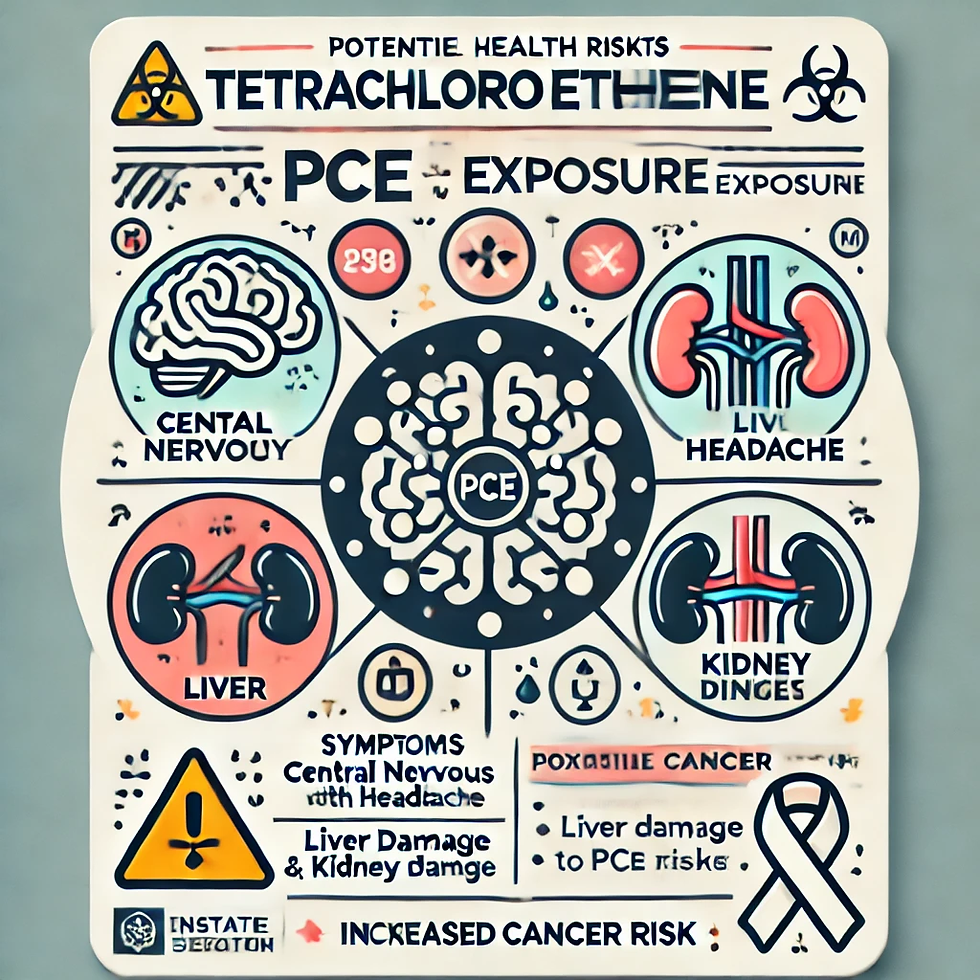Understanding the Pathway and Risks of Tetrachloroethylene (PCE) in the Human Body
- Gavin Lottering
- Jun 25, 2024
- 2 min read
Introduction
Tetrachloroethylene, commonly known as perchloroethylene (PCE), is a chemical widely used in industrial applications such as dry cleaning and degreasing operations. While its utility is undeniable, it's crucial to understand how PCE interacts with the human body and the potential health risks associated with its exposure.

Metabolism of PCE in the Human Body
When PCE enters the body, primarily through inhalation or skin contact, it follows a specific metabolic pathway:
Exhalation and Minimal Metabolism:
The majority of PCE is exhaled unchanged. However, a small fraction (about 1-3%) undergoes metabolism.
Formation of Tetrachloroethylene Oxide:
The cytochrome P450 enzyme, specifically CYP2E1, metabolizes PCE into tetrachloroethylene oxide, an unstable epoxide intermediate.
Isomerization to Trichloroacetyl Chloride:
Tetrachloroethylene oxide rapidly isomerizes to form trichloroacetyl chloride, a more reactive intermediate.
Hydrolysis to Trichloroacetic Acid:
Trichloroacetyl chloride hydrolyzes in the presence of water to form trichloroacetic acid, which can then be excreted from the body.
Elimination of Metabolites
The body efficiently processes and eliminates these metabolites through:
Renal Excretion:
Trichloroacetic acid is primarily excreted in the urine.
Conjugation Reactions:
Reactive intermediates are neutralized by conjugation with glucuronic acid or glutathione, making them more water-soluble for excretion.
Biliary Excretion:
Some conjugated metabolites are excreted into the bile and eliminated through feces.

Risks of PCE Accumulation
If the body cannot effectively eliminate PCE, several adverse effects may occur:
Acute Toxicity:
High levels of PCE can depress the central nervous system, leading to dizziness, headache, nausea, and in severe cases, loss of consciousness or coma.
Chronic Toxicity:
Liver Damage: Prolonged exposure can result in liver damage due to the hepatotoxicity of reactive metabolites.
Kidney Damage: Chronic exposure can impair kidney function, potentially leading to kidney failure.
Carcinogenic Potential: PCE is classified as a potential human carcinogen, associated with an increased risk of certain cancers.
Neurotoxicity: Long-term exposure can lead to cognitive impairment, mood disturbances, and peripheral neuropathy.

Sources of PCE Ingestion
PCE can be ingested through various environmental and occupational sources:
Contaminated Drinking Water:
PCE can leach into groundwater and surface water, leading to ingestion through contaminated drinking water supplies.
Soil Contamination:
PCE can contaminate soil near industrial areas, with potential migration to groundwater and uptake by crops.
Dry Cleaning Residue:
Residue from dry-cleaned clothes can transfer to the skin or air, leading to indirect ingestion.
Household Products:
Products such as spot removers, adhesives, and degreasers containing PCE can lead to accidental ingestion.
Food Packaging and Contaminated Food:
PCE can migrate from contaminated packaging materials into food, and crops grown in contaminated soil can absorb PCE, leading to ingestion.

Preventive Measures
To mitigate the risks associated with PCE exposure:
Ensure Safe Drinking Water: Regularly test and treat drinking water sources to detect and remove PCE contamination.
Regulate Industrial Practices: Implement stringent regulations and best practices for the use, handling, and disposal of PCE.
Personal Protective Equipment (PPE): Ensure workers use appropriate PPE and follow hygiene practices.
Monitor Food Sources: Regularly test food and packaging materials for PCE contamination.
Conclusion
Understanding the metabolic pathway and potential health risks of PCE is crucial for developing effective safety protocols and regulatory measures. By taking proactive steps to monitor and control PCE exposure, we can protect human health and ensure safer industrial and environmental practices.


Comments